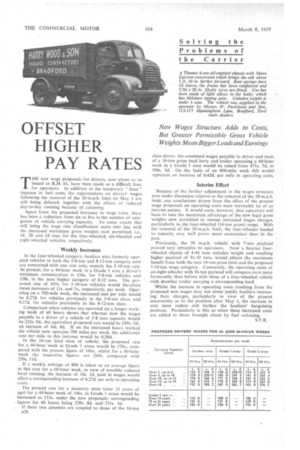OFFSET HIGHER PAY RATES
Page 62

If you've noticed an error in this article please click here to report it so we can fix it.
THE new wage proposals for drivers, now about to be issued as R.H. 61, have been made at a difficult time for operators. In addition to the temporary " Suez" increase in fuel costs, the repercussions on drivers' wages following the removal of the 20-mph. limit on May 1 arc still being debated, together with the effects of reduced day-to-day running because of rationing.
Apart from the proposed increases in wage rates, there has been a reduction from six to five in the number of categories of vehicle carrying capacity. To some extent this will bring the wage rate classification more into line with the increased maximum gross weights now permitted. i.e., 14. 20 and 24 tons for the four-wheeled, six-wheeled and eight-wheeled vehicles, respectively.
Weekly Increases
In the four-wheeled category, hauliers who formerly operated vehicles in both the 5-8-ton and 8-12-ton category now are concerned with one rate only, namely the 5-10-ton rate. At present, for a 44-hour week in a Grade 1 area a driver's minimum remuneration is 154s. for 5-8-ton vehicles and I58s. in the next higher category of 8-12 tons. The proposed rate of 165s. for 5-10-ton vehicles would therefore mean increases of Ils. and 7s., respectively, per week. Operating on a 500-mile week, the increased cost per mile would be 0.27d. for vehicles previously in the 5-8-ton class, and 0.17d. for vehicles previously in the 8-12-ton class.
Comparison when vehicles are operated on a longer working week of 60 hours shows that whereas now the wages payable to a driver of a vehicle of 5-8 tons capacity would be 232s. 9d., the equivalent proposed rate would be 249s. 5d-, an increase of 16s. 8d. , If on the increased hours worked the vehicle now operates 700 miles per week, the additional cost per mile in this instance would be 0.28d.
In the 16-ton load class of vehicle, the proposed rate for a 44-hour week in Grade 1 areas would be 178s., cornpared with the present figure of 166s., whilst for a 60-hour week the respective figures are 269s, compared with 250s. lid.
If a weekly mileage of 800 is taken as an average figure in this case for a 60-hour week, in view of possible reduced local running, the increase of 18s. Id. paid in wages would effect a corresponding increase of 0.27d. per mile in operating costs.
The present rate for a statutory mate (over 21 years of age) for a 44-hour week of 146s, in Grade 1 areas would be increased to 153s. under the new proposals; corresponding figures for 60 hours being 220s, 8d. and 231s. 3d.
If these two amounts are coupled to those of the 16-ton 1328 class driver, the combined wages payable to driver and mate of a 16-ton gross load lorry and trailer operating a 60-hour week in a Grade 1 area would be raised from 471s. 7d. to 500s. 3d. On the basis of an 800-mile week thiS would represent an increase of 0.43d. per mile in operating costs.
Interim Effect Because of the further adjustment in the wages structure now under discussion relative to the removal of the 20-m.p.h. limit, any conclusions drawn from the effect of the present wage proposals on operating costs must inevitably be of an interim nature. It would seem, however, that operators-will have to take the maximum advantage of the new legal gross weights now permitted to recoup increased wages charges, particularly in the four-wheeled (I4-ton gross) range. With the removal of the 20-m.p.h. limit, the four-wheeler loaded to capacity may well prove more economical than in the past.
Previously, the 30 m.p.h. vehicle with 7-ton payload proved very attractive to operators. Now a heavier fourwheeled chassis of 4-4+ tons unladen weight and resulting higher payload of 94-10 tons, would obtain the maximum benefit from both the new 14-ton gross limit and the proposed 5-10-ton wage category. Conversely, the operating costs of an eight-wheeler with I6-ton payload will compare even more favourably than before with those of a four-wheeled vehicle with drawbar trailer carrying a corresponding load.
Whilst the increase in operating costs resulting from the proposed new wages may not alone justify hauliers increasing their charges, particularly in view of the present uncertainty as to the position after May 1, the increase in cost must reduce still further the hauliers' bargaining position. Particularly is this so when these increased costs are added to those brought about by fuel rationing.
S.T.R.




































































































